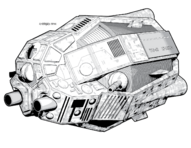Foxhound (Small Craft class)

| |
| TiG-40 Foxhound Gunboat | |
| Production information | |
| Manufacturer | Vandenberg Mechanized Industries |
| Use | Gunship |
| Type (Shape) | Military Spheroid |
| Tech Base | Inner Sphere (Advanced) |
| Cost | N/A |
| Introduced | 3083 |
| Technical specifications | |
| Mass | 180 Tons |
| Structural Integrity | 9 |
| Length | 33 meters |
| Engine (Type) | Fusion |
| Safe Thrust | 5 |
| Maximum Thrust | 8 |
| Fuel | 8 Tons |
| Burn Rate | |
| Armament | 2 x Improved Heavy Gauss Rifles 2 x ER Large Lasers 2 x Laser AMS |
| Armor | Heavy Ferro-Aluminium Armor |
| Heat Sinks | 20 Double Heat Sinks |
| Crew | 4 (3 enlisted/non-rates, 1 gunner) |
| Passengers | 0 |
| BV (1.0) | N/A |
| BV (2.0) | 3,452[1][2][3] |
Description
Built for the Taurian Concordat as a defensive vessel, the Foxhound is a product of the nation's need for protecting borders from unwanted incursions. Intended for short endurance patrols, the ship carries limited fuel and a small crew for its missions.[4]
Armament & Capacities
Using a blend of Advance Technology that was acquired during the Concordat's brief technology exchange with the Word of Blake. The craft's long-range weaponry includes a pair of Extended Range Large Lasers mounted in the nose. On each of the craft's sides, exist its most potent weapons; Improved Heavy Gauss Rifles. Each of the Rifles are feed by four tons of ammunitions which keep these weapons well feed throughout combat.
The Foxhound's defensive capacities consist of two Laser Anti-Missile Systems split between the nose and its aft sections. To increase its survival in the rigors of heavy combat, the craft is protected by 16.5 tons of Heavy Ferro-Aluminium armour, while its engines propel the craft at a modest rate speed to be able to intercept potential targets.[5]
Design Notes
The craft is fitted with Steerage-Class style quarters for its crew.
The Foxhound is subject of the following Design Quirks:


